Good morning. This has been sooooo interesting and a learning experience of what there is still to learn in this hobby. The quality of your work is impeccable as well. Thank you for sharing this with us. CheersI made this small area in principle like I did also at the Le Coureur - unfortunately I did not make any photos here with the Granado, but in the for information some older photo of the lugger
View attachment 289779 View attachment 289780
View attachment 289781 View attachment 289778
LE COUREUR - french Lugger 1776 - POF kit from CAF in 1:48 by Uwe
Hello Uwe, I like the plain toothpick as well, bear in mind, if you will decide to oil the deck, it will actually emphasize the caulking effect (it will darken the around the hole). :)shipsofscale.com
Many thanks for this comment - in the meantime I made the treenailing also on the waterway plank vut really forgot the one treenail at the end of the first plank.
I will make it soon - Many Thanks for the supervising and comment
Many Thanks for the positive feedback Mirek
-

Win a Free Custom Engraved Brass Coin!!!
As a way to introduce our brass coins to the community, we will raffle off a free coin during the month of August. Follow link ABOVE for instructions for entering.
-

PRE-ORDER SHIPS IN SCALE TODAY!
The beloved Ships in Scale Magazine is back and charting a new course for 2026!
Discover new skills, new techniques, and new inspirations in every issue.
NOTE THAT OUR FIRST ISSUE WILL BE JAN/FEB 2026
You are using an out of date browser. It may not display this or other websites correctly.
You should upgrade or use an alternative browser.
You should upgrade or use an alternative browser.
HMS GRANADO (1742) - midship section - POF by CAF in 1:48 - by Uwe
I made for me a very big step and painted some elements red - usually I like it more to have everything, even the wales, in the original timber color - but with this section model I tried it first time - and I am still not sure, if I like it.......
Maybe it is also because usually I build in pear, Elsbeere or cherry but now this section model is boxwood, which has a much lighter brown colour, slightly going into yellow. So some contrast is maybe not so bad ...... but take a look .....
and I am trying to show also the striptease, which was necessary to make the morter Ready for action with dismantling the roof and pit elements
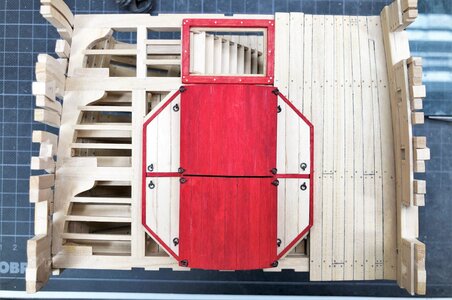
the two roof elements received their eyebolts for lifting
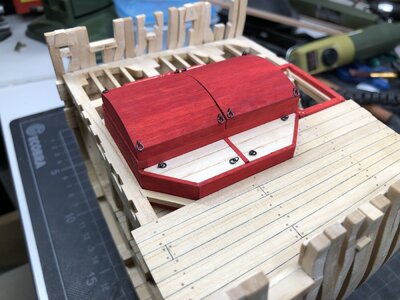
with the help of tackles and a yrad-arm the elements were dismantled
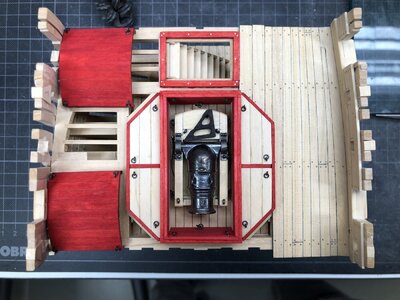
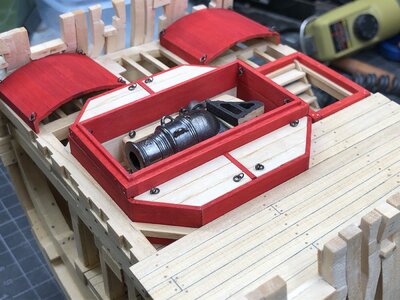
covers of the side elements were layed on side - I guess here were the tackles for the mortar stowed
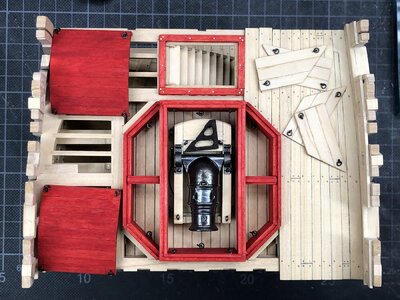
It is getting already growdy on the deck
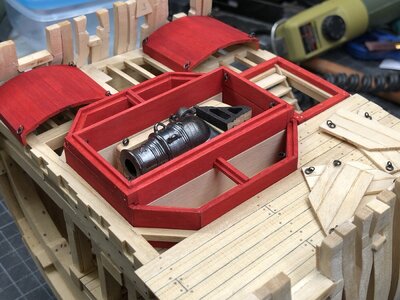
the pit bulkhead frame was also lifted away
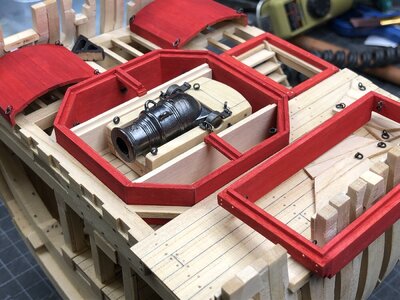
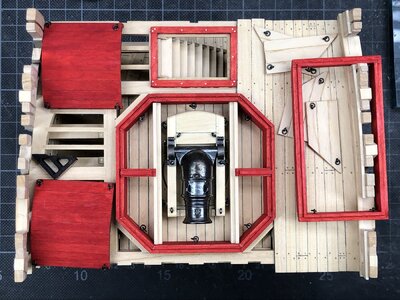
now also the small girders and the two inner bukhead walls away - after installation of the tackles (still missing) the mortar could be turned
BTW: the last photo is showing more or less the real colours (the other photos are much lighter (and colder) because of the articial lights in the workshop) - so the red is not so pinky
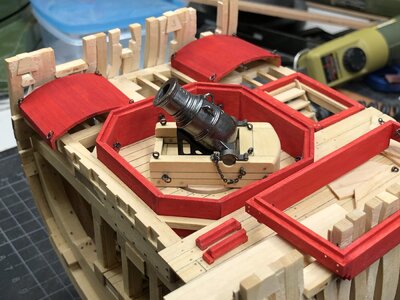
Imagine how crowdy it was on the deck, you should add here in addition the four "normal" guns, somewhere were also the oars stowed, spare anchor etc etc.
Maybe they dismantled these pit elements and stowed them on the tender ships, which were delivering the powder and the amunition......
Maybe it is also because usually I build in pear, Elsbeere or cherry but now this section model is boxwood, which has a much lighter brown colour, slightly going into yellow. So some contrast is maybe not so bad ...... but take a look .....
and I am trying to show also the striptease, which was necessary to make the morter Ready for action with dismantling the roof and pit elements

the two roof elements received their eyebolts for lifting

with the help of tackles and a yrad-arm the elements were dismantled


covers of the side elements were layed on side - I guess here were the tackles for the mortar stowed

It is getting already growdy on the deck

the pit bulkhead frame was also lifted away


now also the small girders and the two inner bukhead walls away - after installation of the tackles (still missing) the mortar could be turned
BTW: the last photo is showing more or less the real colours (the other photos are much lighter (and colder) because of the articial lights in the workshop) - so the red is not so pinky

Imagine how crowdy it was on the deck, you should add here in addition the four "normal" guns, somewhere were also the oars stowed, spare anchor etc etc.
Maybe they dismantled these pit elements and stowed them on the tender ships, which were delivering the powder and the amunition......
That looks great, Uwe.I made for me a very big step and painted some elements red - usually I like it more to have everything, even the wales, in the original timber color - but with this section model I tried it first time - and I am still not sure, if I like it.......
Maybe it is also because usually I build in pear, Elsbeere or cherry but now this section model is boxwood, which has a much lighter brown colour, slightly going into yellow. So some contrast is maybe not so bad ...... but take a look .....
and I am trying to show also the striptease, which was necessary to make the morter Ready for action with dismantling the roof and pit elements
View attachment 289958
the two roof elements received their eyebolts for lifting
View attachment 289959
with the help of tackles and a yrad-arm the elements were dismantled
View attachment 289960
View attachment 289961
covers of the side elements were layed on side - I guess here were the tackles for the mortar stowed
View attachment 289962
It is getting already growdy on the deck
View attachment 289963
the pit bulkhead frame was also lifted away
View attachment 289965
View attachment 289964
now also the small girders and the two inner bukhead walls away - after installation of the tackles (still missing) the mortar could be turned
BTW: the last photo is showing more or less the real colours (the other photos are much lighter (and colder) because of the articial lights in the workshop) - so the red is not so pinky
View attachment 289966
Imagine how crowdy it was on the deck, you should add here in addition the four "normal" guns, somewhere were also the oars stowed, spare anchor etc etc.
Maybe they dismantled these pit elements and stowed them on the tender ships, which were delivering the powder and the amunition......
Have you painted it with Red Ecoline? So yes, what color number? I am experimenting with the 318, Carmine Red.
Regards, Peter
Uwe, it looks good but it also looks like too much contrast? Now perhaps you need to introduce more paint colors to tone down the RED!  I always prefer a colored wood on models that use fine woods, the boxwood has its own charm and perhaps some Pear or Redheart would be more subtle and beautiful, I think paint is great to make a model that doesn’t use high quality wood look better, or if you are painting everything for historical accuracy- in which case you would not use boxwood to frame it. But that is my 2 cents worth.
I always prefer a colored wood on models that use fine woods, the boxwood has its own charm and perhaps some Pear or Redheart would be more subtle and beautiful, I think paint is great to make a model that doesn’t use high quality wood look better, or if you are painting everything for historical accuracy- in which case you would not use boxwood to frame it. But that is my 2 cents worth.
- Joined
- Dec 9, 2019
- Messages
- 951
- Points
- 403

WitajI made for me a very big step and painted some elements red - usually I like it more to have everything, even the wales, in the original timber color - but with this section model I tried it first time - and I am still not sure, if I like it.......
Maybe it is also because usually I build in pear, Elsbeere or cherry but now this section model is boxwood, which has a much lighter brown colour, slightly going into yellow. So some contrast is maybe not so bad ...... but take a look .....
and I am trying to show also the striptease, which was necessary to make the morter Ready for action with dismantling the roof and pit elements
View attachment 289958
the two roof elements received their eyebolts for lifting
View attachment 289959
with the help of tackles and a yrad-arm the elements were dismantled
View attachment 289960
View attachment 289961
covers of the side elements were layed on side - I guess here were the tackles for the mortar stowed
View attachment 289962
Na pokładzie robi się już zarośnięty
View attachment 289963
rama grodzi szybu również została zdjęta
View attachment 289965
View attachment 289964
teraz także małe dźwigary i dwie wewnętrzne ściany grodziowe - po zamontowaniu sprzętu (wciąż brakującego) można było obrócić zaprawę
BTW: ostatnie zdjęcie pokazuje mniej więcej rzeczywiste kolory (pozostałe zdjęcia są znacznie jaśniejsze (i zimniejsze) ze względu na sztuczne światła w warsztacie) - więc czerwień nie jest tak różowa
View attachment 289966
Wyobraź sobie jak ciasno było na pokładzie, powinieneś dodać tutaj dodatkowo cztery "normalne" działa, gdzieś były też schowane wiosła, zapasowa kotwica itp. itd.
Może zdemontowali te elementy szybu i umieścili je na transportowcach, które dostarczały proch i amunicję…
Mnie się bardzo podoba ,wygląda super.
Pozdrawiam Mirek
Hello
I like it very much, it looks great.
Greetings Mirek
Last edited by a moderator:
Great progress Uwe, but I was very surprised by your courageous move to use color and such a strong red at that. If you know your construction diaries and various contributions, you are more of a nature boy . But still cool and clean work as we are used to.
. But still cool and clean work as we are used to.
Kurt Konrath
Kurt Konrath
I have a lot to reread and double check to make my model of this kit anywhere close to as nice as this build has become. 
At least I have a great teacher and example to follow.

At least I have a great teacher and example to follow.
Tough decision you took there. Personally I like it, maybe it's a little too bright but then it's hard to find out what exact tone was used. Maybe there wasn't even just one specific tone of red but several ones, depending what was available to the captains.
Anyway, your build as well as the paint job are so clean it's a joy to look at!
Anyway, your build as well as the paint job are so clean it's a joy to look at!
Many thanks for all the comments and opinions you posted here - I am very happy to have such a discussion in the log.
AS you know, I am more the no-colour modeler, so it was a big step for me - and by myself I am still not convinced about my own work, but .....
Just some additional information
It is known by several contemporary section models, that at this time the pit and / or the roofs and / or the inner side of the rails of bomb vessels like The HMS Granado were painted red
In the following I would like to show the models
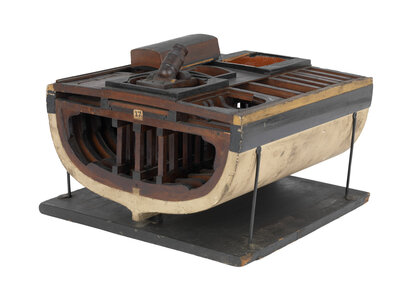
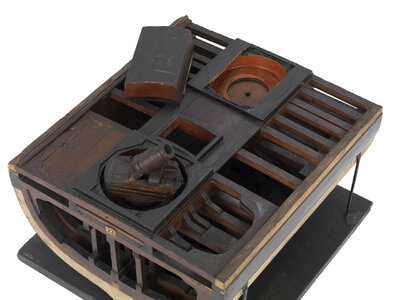
The interior of both mortar pits are finished in a blood red colour.
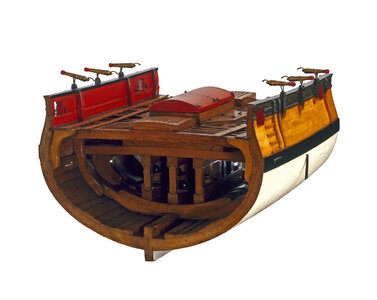
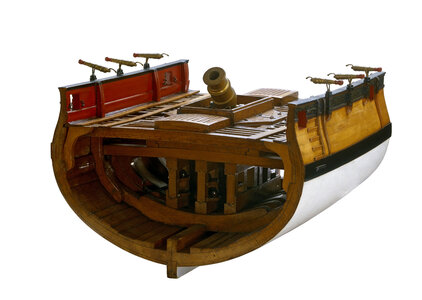
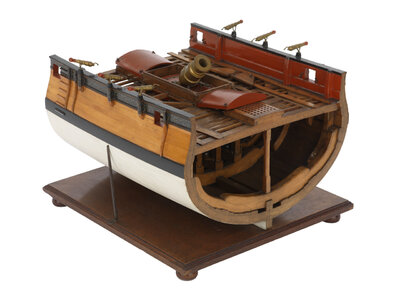
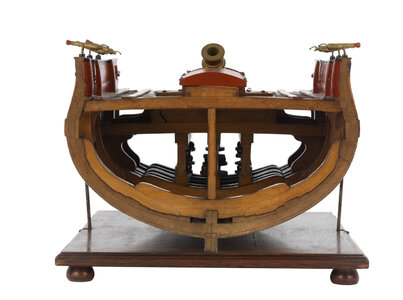
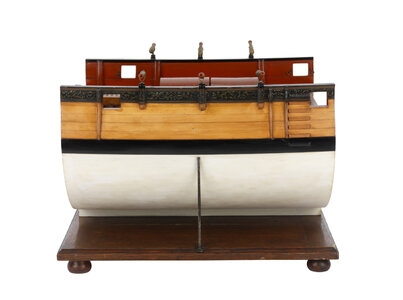
The mortar covers, bed and other details have been painted red.
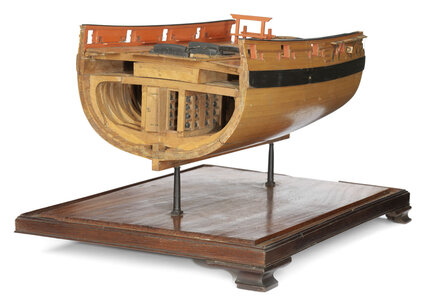
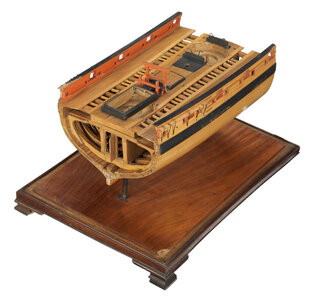
A model depicting the midship section of a bomb vessel, made entirely in wood with metal fittings and partly painted in realistic colours. The external hull, deck beams and planking, and internal structure are finished in varnished or polished wood. The closed wales, gunwales and some deck fittings are painted black. The inboard bulwarks, inner faces of the gunports and sweep ports, and tabernacles are painted red.
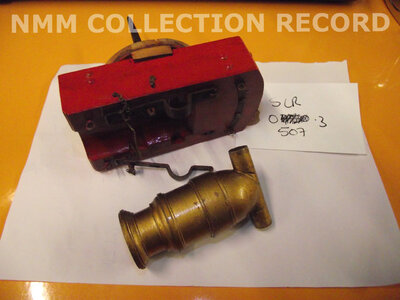
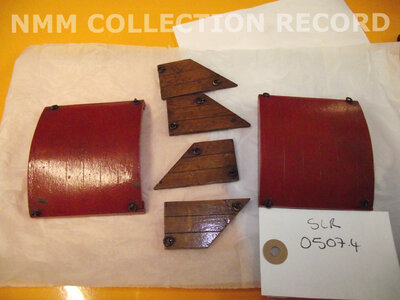
Mortar and bed for the contemporary model of the midship section of a bomb ketch circa 1760
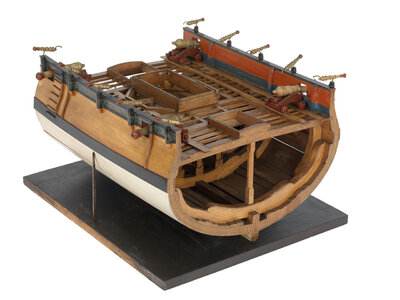
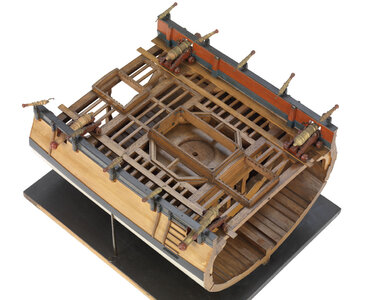
model of a midship section of a bomb vessel made entirely of wood with metal fittings and painted in realistic colours. The model shows the position of a mortar, bed and platform and the strengthening of the ship's timbers to accommodate it. The hull is carved from solid wood and painted white below the waterline with solid black wales above and stained and varnished wood above the wales. A frieze is painted on the bulwarks featuring acanthus leaf decoration on a blue background. The gunwales are painted black and there are five swivel guns mounted on the port and starboard sides. The deck is shown in frame and features two hatches and four large guns on sea service carriages. All the depicted guns are turned in wood, painted gold with red barrel tips. Directly beneath the mortar position strengthened vertical and horizontal timbers encompass a two-tier shot rack. The model is displayed on a black painted display wooden rectangular baseboard with a pair of stabiliser supports, in an original display case, glazed on all four sides and top.
 www.rmg.co.uk
www.rmg.co.uk
So we can defintely see, that several parts of such a bomb vessel were painted red
- inside of the rails
- gunports and openings for the oars
- sometimes the roof covers
- sometimes the mortar carriage / bed
and
- sometimes the mortar pit
AS you know, I am more the no-colour modeler, so it was a big step for me - and by myself I am still not convinced about my own work, but .....
Just some additional information
It is known by several contemporary section models, that at this time the pit and / or the roofs and / or the inner side of the rails of bomb vessels like The HMS Granado were painted red
In the following I would like to show the models


The interior of both mortar pits are finished in a blood red colour.





The mortar covers, bed and other details have been painted red.


A model depicting the midship section of a bomb vessel, made entirely in wood with metal fittings and partly painted in realistic colours. The external hull, deck beams and planking, and internal structure are finished in varnished or polished wood. The closed wales, gunwales and some deck fittings are painted black. The inboard bulwarks, inner faces of the gunports and sweep ports, and tabernacles are painted red.


Mortar and bed for the contemporary model of the midship section of a bomb ketch circa 1760


model of a midship section of a bomb vessel made entirely of wood with metal fittings and painted in realistic colours. The model shows the position of a mortar, bed and platform and the strengthening of the ship's timbers to accommodate it. The hull is carved from solid wood and painted white below the waterline with solid black wales above and stained and varnished wood above the wales. A frieze is painted on the bulwarks featuring acanthus leaf decoration on a blue background. The gunwales are painted black and there are five swivel guns mounted on the port and starboard sides. The deck is shown in frame and features two hatches and four large guns on sea service carriages. All the depicted guns are turned in wood, painted gold with red barrel tips. Directly beneath the mortar position strengthened vertical and horizontal timbers encompass a two-tier shot rack. The model is displayed on a black painted display wooden rectangular baseboard with a pair of stabiliser supports, in an original display case, glazed on all four sides and top.
Collection Results | Royal Museums Greenwich
So we can defintely see, that several parts of such a bomb vessel were painted red
- inside of the rails
- gunports and openings for the oars
- sometimes the roof covers
- sometimes the mortar carriage / bed
and
- sometimes the mortar pit
In addition we have the interesting model made by Robert Lightley
The model illustrates how the mortars were operated and where the shells were stowed down below, and it is also has a set of large sweeps or oars as a backup should the wind drop and minor re-positioning be required. Such is the high standard of modelmaking, it was awarded the gold medal in the National Maritime Museum’s First International Ship Model Competition held in Greenwich in 1975.
Vessels of this type were one of many of the ketch-rigged vessels built in the merchant yards. The ketch rig enabled the positioning of two sea mortars amidships and provided a stable platform from which to operate. The ‘bombs’, as they were known, were anchored off shore and employed in bombarding enemy coastal fortifications.
The ‘Grenado’ measured 91 feet along the maindeck by 26 feet in the beam and was 279 tons burden. It had an eventful career and was present at the attack on Martinique in 1759, the capture of Guadeloupe in 1759, the capture of Martinique and the Havana expedition in 1762. It was eventually sold the following year.
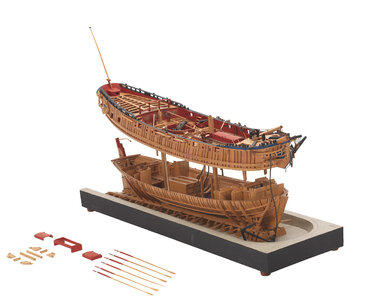
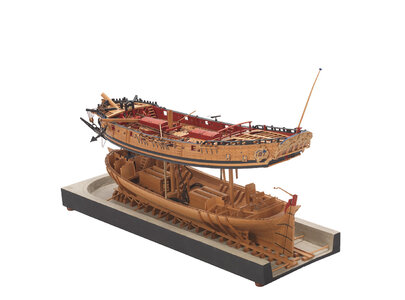
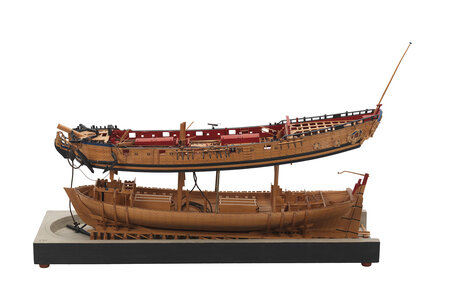
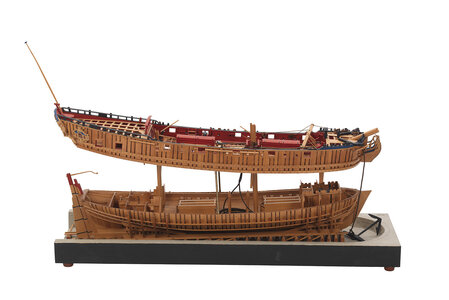
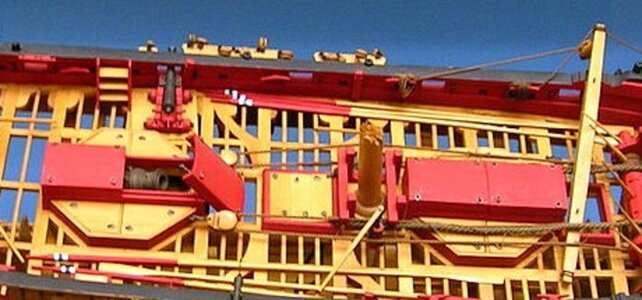
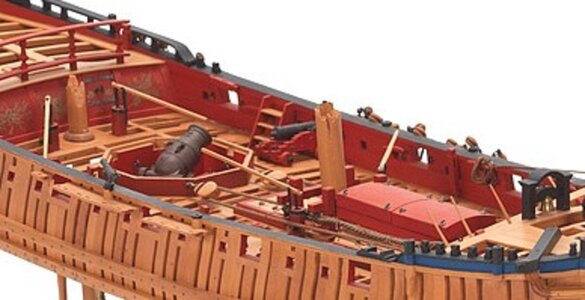
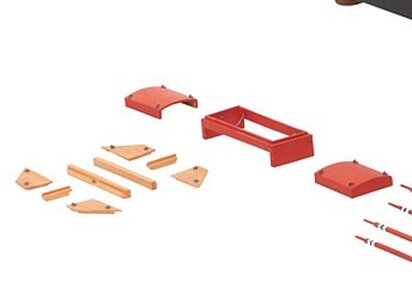
Up to now I partly followed the painting schema visible on this amazing model
Grenado (1742); Fighting vessel; Bomb vessel
Scale: 1: 48. A full hull and partially planked model of the ‘Grenado’ (1742), a bomb ketch fitted with two 12-inch mortars. The model has been designed to lift apart to reveal the internal construction and layout of an 18th-century bomb vessel. The hull is almost entirely built from boxwood but the mortars have been turned in ebony and painted to represent bronze. It is complete with a wealth of removable parts allowing a visual deconstruction.The model illustrates how the mortars were operated and where the shells were stowed down below, and it is also has a set of large sweeps or oars as a backup should the wind drop and minor re-positioning be required. Such is the high standard of modelmaking, it was awarded the gold medal in the National Maritime Museum’s First International Ship Model Competition held in Greenwich in 1975.
Vessels of this type were one of many of the ketch-rigged vessels built in the merchant yards. The ketch rig enabled the positioning of two sea mortars amidships and provided a stable platform from which to operate. The ‘bombs’, as they were known, were anchored off shore and employed in bombarding enemy coastal fortifications.
The ‘Grenado’ measured 91 feet along the maindeck by 26 feet in the beam and was 279 tons burden. It had an eventful career and was present at the attack on Martinique in 1759, the capture of Guadeloupe in 1759, the capture of Martinique and the Havana expedition in 1762. It was eventually sold the following year.







Up to now I partly followed the painting schema visible on this amazing model
and we have this contemporary painting made by John Clevely in 1748
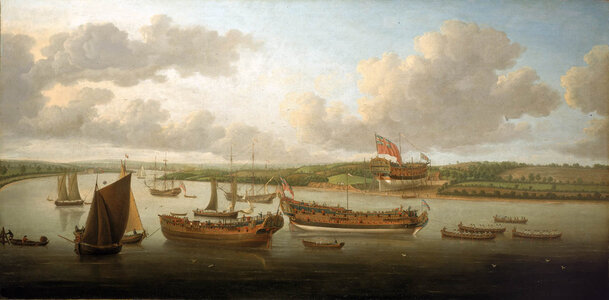
This is believed to be a picture of the first three naval vessels built by John Barnard the Younger for the Navy Board. It is a composite in both time and subject and is thought to show the 'Hampshire', 50 guns, on the stocks, the 'Biddeford', 20 guns, being towed downstream and, in the left foreground, the 'Grenado', a bomb-vessel. The location is the River Orwell and the artist was positioned in the immediate vicinity of the Frensham Tower several miles downstream of Ipswich, immediately identifiable in the middle distance. The land on which the ship sits ready for launch is John's Ness, where the 'Hampshire' was the only 50-gun ship was built and was launched there in 1741. The 'Biddeford', a sixth-rate, was built upstream at St Clement's Yard and launched in 1740. She was towed downstream to Harwich to be rigged: no other 20-gun ship was built upstream of John's Ness. This painting shows the boats involved in towing. The 'Grenado' was also built at the St Clement's Yard, the only bomb ketch ever built there, and was launched in 1742. In the picture she is shown without masts but the positioning of her mizzenmast indicates her rig. The bomb ketch was a relatively uncommon vessel with distinctive lines. It is not known why Cleveley selected these three Barnard-built ships launched in different years to appear in the same picture. The work may have been commissioned from him by the Barnard family but no evidence exists to support this.
 collections.rmg.co.uk
collections.rmg.co.uk
https://commons.wikimedia.org/wiki/...unch_of_a_Fourth-Rate_on_the_River_Orwell.jpg
when we take a closer look
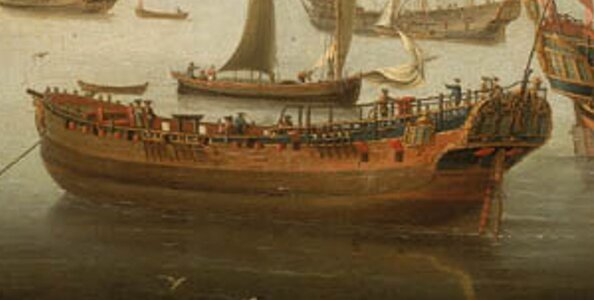
so the painting schema is more or less confirmed


This is believed to be a picture of the first three naval vessels built by John Barnard the Younger for the Navy Board. It is a composite in both time and subject and is thought to show the 'Hampshire', 50 guns, on the stocks, the 'Biddeford', 20 guns, being towed downstream and, in the left foreground, the 'Grenado', a bomb-vessel. The location is the River Orwell and the artist was positioned in the immediate vicinity of the Frensham Tower several miles downstream of Ipswich, immediately identifiable in the middle distance. The land on which the ship sits ready for launch is John's Ness, where the 'Hampshire' was the only 50-gun ship was built and was launched there in 1741. The 'Biddeford', a sixth-rate, was built upstream at St Clement's Yard and launched in 1740. She was towed downstream to Harwich to be rigged: no other 20-gun ship was built upstream of John's Ness. This painting shows the boats involved in towing. The 'Grenado' was also built at the St Clement's Yard, the only bomb ketch ever built there, and was launched in 1742. In the picture she is shown without masts but the positioning of her mizzenmast indicates her rig. The bomb ketch was a relatively uncommon vessel with distinctive lines. It is not known why Cleveley selected these three Barnard-built ships launched in different years to appear in the same picture. The work may have been commissioned from him by the Barnard family but no evidence exists to support this.
Launch of a Fourth-Rate on the River Orwell | Royal Museums Greenwich
https://commons.wikimedia.org/wiki/...unch_of_a_Fourth-Rate_on_the_River_Orwell.jpg
when we take a closer look

so the painting schema is more or less confirmed

Hallo Peter,That looks great, Uwe.
Have you painted it with Red Ecoline? So yes, what color number? I am experimenting with the 318, Carmine Red.
Regards, Peter
Yes - it is ecoline with the brushpen
I ordered all available ecoline colours and made several trials with the boxwood timber before I made a decision.
This was my sample sheet I used - on top a boxwood strip which I made yesterday in addition to show you in addition the differences
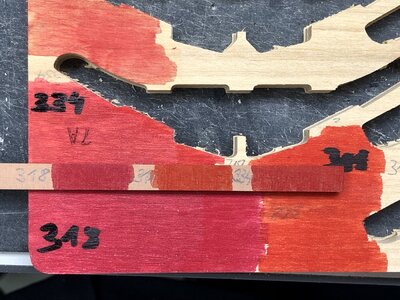
the 311 is going slightly into orange
the 318 somehow pinky or purple
-> so I decided to use the 334
on top a pear wood strip - the second one is the boxwood - here on a darker background
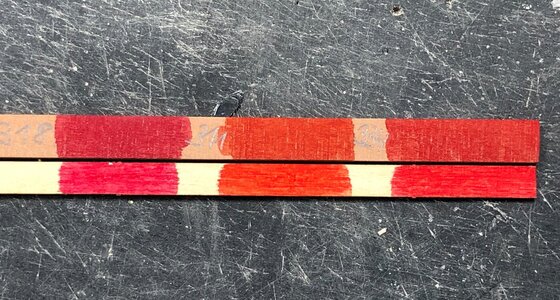
on a white background
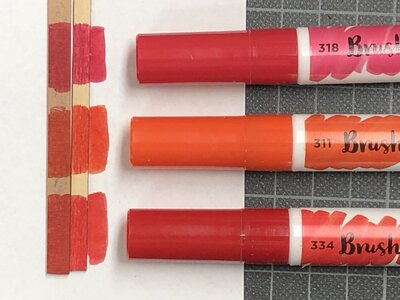
and on the dark background
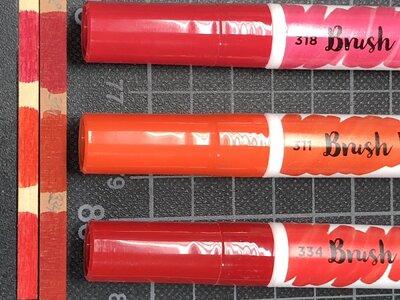
Hope this is helping - but the camera, the artificial light, the timber -> all this has an influence how the color is shown in the photos
Hello Uwe, I think you can very well be convinced of your work, because it is great. And as the saying goes, courage to take a leap.
- Joined
- Dec 9, 2019
- Messages
- 951
- Points
- 403

WitajIn addition we have the interesting model made by Robert Lightley
Grenado (1742); Fighting vessel; Bomb vessel
Scale: 1: 48. A full hull and partially planked model of the ‘Grenado’ (1742), a bomb ketch fitted with two 12-inch mortars. The model has been designed to lift apart to reveal the internal construction and layout of an 18th-century bomb vessel. The hull is almost entirely built from boxwood but the mortars have been turned in ebony and painted to represent bronze. It is complete with a wealth of removable parts allowing a visual deconstruction.
The model illustrates how the mortars were operated and where the shells were stowed down below, and it is also has a set of large sweeps or oars as a backup should the wind drop and minor re-positioning be required. Such is the high standard of modelmaking, it was awarded the gold medal in the National Maritime Museum’s First International Ship Model Competition held in Greenwich in 1975.
Vessels of this type were one of many of the ketch-rigged vessels built in the merchant yards. The ketch rig enabled the positioning of two sea mortars amidships and provided a stable platform from which to operate. The ‘bombs’, as they were known, were anchored off shore and employed in bombarding enemy coastal fortifications.
„Grenado” mierzyło 91 stóp wzdłuż głównego pokładu na 26 stóp w belce i ważyło 279 ton. Miał burzliwą karierę i był obecny podczas ataku na Martynikę w 1759, zdobycia Gwadelupy w 1759, zdobycia Martyniki i ekspedycji do Hawany w 1762. Ostatecznie sprzedano go w następnym roku.
View attachment 290089
View attachment 290090
View attachment 290087
View attachment 290088
View attachment 290084
View attachment 290085
View attachment 290086
Do tej pory częściowo podążałem za schematem malowania widocznym na tym niesamowitym modelu
Gdybym do budował ten model poszedłbym za modelem z muzeum jest piękny
Pozdrawim Mirek
Thanks, Uwe.Hallo Peter,
Yes - it is ecoline with the brushpen
I ordered all available ecoline colours and made several trials with the boxwood timber before I made a decision.
This was my sample sheet I used - on top a boxwood strip which I made yesterday in addition to show you in addition the differences
View attachment 290096
the 311 is going slightly into orange
the 318 somehow pinky or purple
-> so I decided to use the 334
on top a pear wood strip - the second one is the boxwood - here on a darker background
View attachment 290097
on a white background
View attachment 290099
and on the dark background
View attachment 290098
Hope this is helping - but the camera, the artificial light, the timber -> all this has an influence how the color is shown in the photos
Thanxs for this comparison of your Red's.
By you it is boxwood, by me it is pear.
Just post my 2e test in my build log. With I reply of your reaction, so you will get the alert.
Buy for the other viewers:
-> Ecoline Test <-
Regards, Peter
Hallo Radek,Hi Uwe!
Can you please send a photo of the whole coloring pen Ecoline?
Thank you!
Radek
this is a photo I made some months ago, when I received my first Talens Ecoline paints. You can get them in small glasbottles or as brush pens - I can fully recommend these..... btw: I got the hint once by @Maarten in his building log......
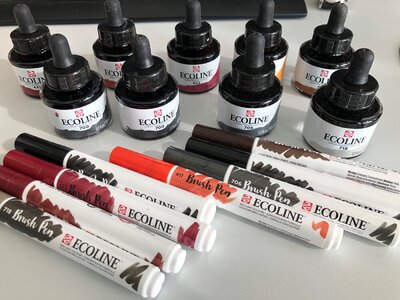
Great work Uwe, I am very interested in your colours.
HI UWE, IN MY HUMBLE OPION I LOVE THE RED WEATHER ACCURATE OR NOT JUST BEAUTIFUL, I TOO USE TH ECOLINE RIGHT NOW USING THE BRUSH PENS GETTING SOME LIQUID I TOO GOT THIS FRO MAARTEN HE TOLD ME HE USES THE LIQUIDS AS PAINT AND ME DO NOT GET ALONG ANYTHING I NEED TO PAINT I USE THE ECOLINE NOW GETTING SOME LIQUID TO TRY IT OUT ALSO. GOD BLESS STAY SAFE YOU AND YOURS DON






